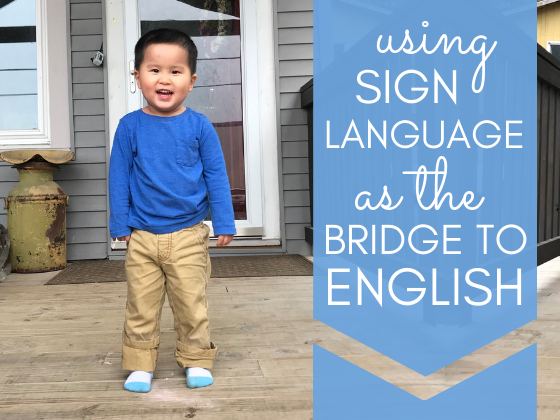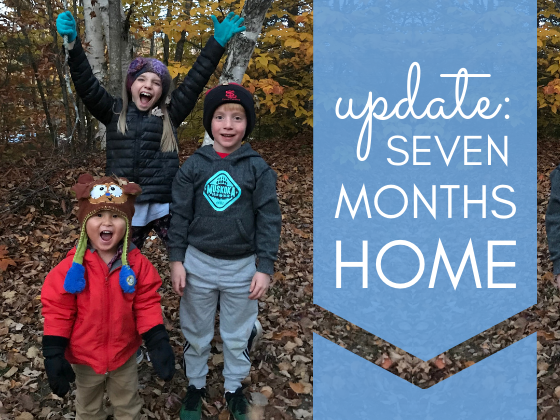USING SIGN LANGUAGE AS THE BRIDGE TO ENGLISH
_________________________________________________________
_________________________________________________________
I mentioned in my last post that we were using sign language to help Benjamin understand the concept of patience. Implementing the use of sign language to communicate with Benjamin was the very first thing we did after meeting him, and it has by far been the biggest win in bringing him home.
What do you do when you're two-years-old and you don't speak the same language as the family who adopted you?
Point and either whine or yell. And Ben is very impressive at doing both.
When you're scared and you don't know if the people who just adopted you will give you what you need, you make it as clear (and as loud) as possible that you have a need that needs to be met. Brad and I knew we could fulfill Benjamin's needs but Benjamin didn't know that. To help him understand that, we started by signing more during meals. Every. single. bite required a more sign. We would point to a particular food, ask him if he wanted more and sign it at the same time. Benjamin would sign it back and he would get more of that particular food.
I realize as I type those sentences that requiring a two-year-old to ask for every single bite of food might come across as severe and even appalling. But Benjamin caught on to signing for more within the first meal we ate together. Food was never withheld from him and it was a very tangible way for him to see that he was capable of expressing his need and we were capable of fulfilling it. Having that foundation (three times a day plus snacks) helped to create a sense of trust in other non-food areas of his relationship with us.
To create the same trust relationship in non-food related situations, we used the sign for please. If there was anything Benjamin needed or wanted (like being picked up, getting a toy, wanting his shoes put on, etc.) initially Benjamin would point and whine (which would escalate into yelling if we didn't figure out what he was trying to communicate soon enough). I would say that Brad and I knew what he wanted or needed 85% of the time but instead of fulfilling his request right away, we would say and sign the word please. Benjamin would sign the word back and then we would fulfill his request.
It didn't take long for Benjamin to point and sign please for something he wanted as opposed to whining for it which, is music to everyone's ears whether you're the parent or not.
So that's what we started with - just two signs: more and please. Benjamin had both of these down within 48 hours.
Now, please don't get me wrong, sign language is not fairy dust. Benjamin still whines and has meltdowns and temper tantrums at times but the quantity has decreased significantly as we've been able to give him ways to communicate with us. More so, giving him proof over and over and over again that he can request something of us and we can fulfill that request gives him confidence that his needs will be me. And met needs = no need for tantrums.
Shortly after we introduced more and please, we introduced all done or finish.
This was initiated at meal and snack times when food was visually and literally gone. We'd show Benjamin the empty bowl or plate and sign and say all done. As Benjamin began to understand all done in relation to food, we were able to carry over the idea to situations outside the dinner table. For example, we could use it when we needed to leave a room or building, when Benjamin needed to stop playing with a toy, when I was finished changing his diaper, if there was something unsafe for Benjamin to touch, etc.
All done was a harder concept for Benjamin to trust us with, especially when it required him to be done with a toy he was enjoying or move on to a different activity. However, the more we were able to use all done and prove that even if something is all done it's not gone/done forever, the easier it became for him to trust us.
For example, Benjamin loved holding a spoon during breakfast in the hotel. However, the spoons were the hotel's, not ours so they weren't something we could take with us. It was really hard to get Benjamin to relinquish the spoon at the end of breakfast during the first week we were with him. But after a few days of us using all done, and him seeing proof that there would be another spoon waiting for him the next morning, we were able to sign all done and have him lay the spoon on the table himself as opposed to Brad or I having to take it out of his hand.
Shortly after introducing all done we modified it to "almost" all done but only verbally. The word almost plus the sign for all done was Benjamin's cue that a change was about to happen (i.e. you're going to have to give the spoon back to the hotel staff soon). We kept the wait time for this pretty short - probably no longer than a minute so that Benjamin could associate almost with just giving you a heads up that we're about to move on. This heads up really helped prepare Benjamin for changes or transitions and as he began to understand us in this area, it continued to decrease the number of tantrums we saw.
Since being home, we've added in wait/patient (talked more about in this post), bathroom (i.e. I'm about to change your diaper), thank you (which helps to curb an attitude of entitlement), and drive (i.e. we're about to get in the car and change locations). All the signs (with the exception of thank you) initiate in Benjamin's mind and demonstrate in Benjamin's circumstances cause and effect. When the cause and effect are repeatably predictable, trust begins to form. And when trust is formed, healing can take place.
Alongside signing, Benjamin has also started saying many words in English and copies almost everything we say. It's like having a parrot in the house. He doesn't necessarily understand everything he's saying - like when he told our latest solicitor "By by, I wuv wu!" (Bye, bye, I love you) 🙈- but it's a significant first step in learning English.
If I could only pick one tool to use in transitioning an internationally adopted child home, it would be sign language. Being able to use your hands to communicate when your mouth is having a hard time forming words is priceless. Even Brad and I found ourselves "talking with our hands" more while we were in China trying to communicate with people we met. It's second nature to use your hands to supplement when words aren't enough.
If you're looking to use sign language with your children, adopted or not, don't worry so much about which signs to use or not use, simply pay attention to what you find yourself repeating. If you find yourself saying a particular word or phrase over and over, google the sign for it and try signing alongside speaking. Heck, even make up a sign that works for you! It doesn't necessarily have to be official American Sign Language to work for the small amount of time you're trying to build a communication bridge. Giving your child a means to communicate effectively builds both confidence in themselves and trust in you, and that's a recipe for success both in the short term and the long term 💛


We found the home sign to be very helpful too. When we are driving and almost home or are headed home we would sign that to Nora and after a bit she understood what we meant. This helps with car rides since she gets sick and doesn't enjoy rides very much. Now she says home and signs it. It is so cute! - Linda
ReplyDelete